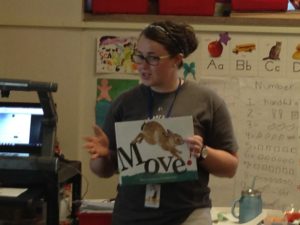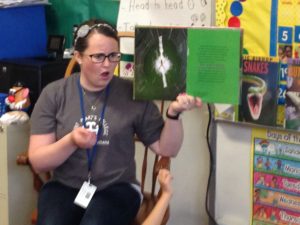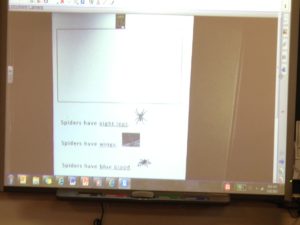

Last year I had the honor of working with two kindergarten teachers who immersed their students in nonfiction author studies. Late in the spring they led a two week author study – week one on Steve Jenkins’ books and week two on Nic Bishop’s books. Monday-Wednesday or Thursday, they read aloud a book and on Fridays, the students could choose their favorite to be read aloud again. The teachers and the students studied the structure of the authors’ texts. For example, Jenkins has three books that follow a question/answer structure – What Do You Do with a Tail Like This?, What Do You Do When Something Wants to Eat You?, How Many Ways Can You Catch a Fly? And they also created writing-in-response centers for the students during the reading block of the day and used the books for mini-lessons during writing workshop. In week two, they contrasted the illustrations in Jenkins’ books with photos in Bishop’s books. (Just a note – What Do You Do with a Tail Like This? is listed in the Common Core Appendix B as an example of an appropriately rigorous read aloud for k-1 students.)
The teachers created writing center activities based on their discussions with students during the interactive read alouds. Sometimes the writing was identifying a fact from the book and then illustrating this fact. In the image below you can see how one teacher projected the response sheet with the document camera for all students to view when she was giving directions. The students are to choose the “true” fact at the bottom and then illustrate in the box above.

Sometimes the writing center was focused on using the structure of the authors’ texts. For example, the students wrote questions about animals they chose and then drew an illustration. I had the pleasure of working with the students at this center one day – they loved asking great questions! How does a jaguar run? Why do cats meow? AND they bugged their teachers to create a writing center where they could not only write questions, but (like Jenkins does) write the answers as well.
Bishop’s books like Frogs, Lizards and so forth are more difficult than some of Jenkins’. They are written in a descriptive text structure and there is a lot of content to grapple with cognitively. I wouldn’t shy away from read them aloud to preK-1st grade students, though. Studying Bishop after studying Jenkins just raises the rigor of the learning that happens – which is aligned with the Common Core. I recommend teachers choose 5-6 pages to read aloud at one time from one of his books and that they allow for quality time spent looking at Bishop’s photos which extend the text in so many ways.
When we’re thinking about moving preK-1 students towards close reading, one of our objectives should be to help students develop an ear for what informational texts sound like – by reading aloud these texts to students – a lot! My recommendation is that when we read aloud an author like Jenkins or Bishop, we should read aloud several of each author’s books so students have a chance to master listening to and understanding these kinds of texts. Experience with the same author multiple times reduces the cognitive load of structure (because the students become familiar with the author’s typical structure and know what to expect) and allows the students to listen for content and glean main ideas. Then when our emergent and early readers begin to read informational text more avidly on their own – they will have these interactive read aloud experiences to draw from as they struggle with increasingly complex texts.
The pay off of immersing students in nonfiction author studies is amazing. Our youngest learners are enthralled with informational books like these. When the kindergarten students were interviewed at the end of the year about what they loved about school, they yelled out these authors names – “Nic Bishop!” and “Steve Jenkins!”
A big thank you to Colleen & Lauren for inspiring your students and sharing your work with us!
